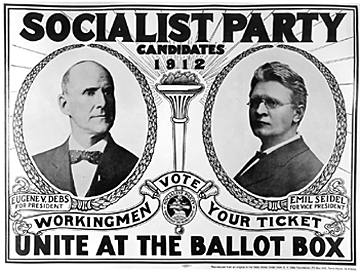 “Socialist administrations were most often elected in small or medium-sized railroad, mining, or industrial centers. Where the worker was not a worker or trade unionist himself, others in the administration often were. In Butte, Montana, the Socialist mayor was a minister; the police judge and city treasurer elected with him in 1911 were miners. In Lackawanna, New York where a socialist mayor (occupation unknown) was elected in 1919, the two Socialist councilmen were trade unionists. Similarly in Davenport, Iowa, which elected a Socialist doctor to the mayoralty in 1920, the Socialist city clerk was a machinist.
“Socialist administrations were most often elected in small or medium-sized railroad, mining, or industrial centers. Where the worker was not a worker or trade unionist himself, others in the administration often were. In Butte, Montana, the Socialist mayor was a minister; the police judge and city treasurer elected with him in 1911 were miners. In Lackawanna, New York where a socialist mayor (occupation unknown) was elected in 1919, the two Socialist councilmen were trade unionists. Similarly in Davenport, Iowa, which elected a Socialist doctor to the mayoralty in 1920, the Socialist city clerk was a machinist.
“Actively pro-labor, these Socialist administrations aided unions in many ways. One of the first acts of the Socialist mayor of Eureka, Utah, for example, had been to arrest and fine a Pinkerton man for carrying a concealed weapon. More substantial was the approach of Marshall E. Kirkpatrick, Socialist mayor of Granite, Illinois (1911, 1913, 1917), a railroad and metal-processing suburb of St. Louis. During strikes, Kirkland wrote, the city administration could not be neutral; true to his Socialist principles, he supported the workers. This could almost always be done by using the police power to allow a ‘fair fight.’ When three hundred metal workers struck, Kirkpatrick followed his own advice and refused a company request for running scabs through a picket line. Similarly, during the Paterson textile strike of 1913, when IWW strikers were refused permission to speak in Paterson, the Socialist mayor of nearby Haledon invited the workers to hold their meetings on his territory. And during the IWW strike in Little Falls, New York, [Socialist] Mayor [George R.] Lunn of Schenectady [New York] helped organize a relief committee to supply the nearby strikes with money, food, and clothing. For this, Bill Haywood praised the Lunn administration and noted that the strikers ‘deeply appreciated’ what these right-wing Socialists had done, even though they could not vote Socialist, ‘as most of them were women and children.’ Finally, in 1917, the Socialist Mayor of Camas, Washington, appointed two strikers at Crown Paper as special deputies, and thereby lost his own job at the mills.”
— James Weinstein, Chapter 2, “Activities and Attitudes, 1912-1917” of The Decline of American Socialism in America: 1912-1925.
Pingback: Socialist Worker and Hillary Clinton Agree: Bernie Sanders’ Campaign Doomed | Revolutionary Democratic Socialism